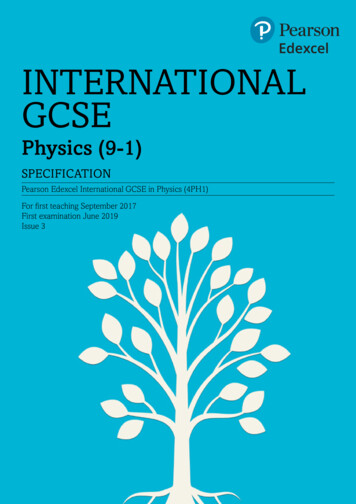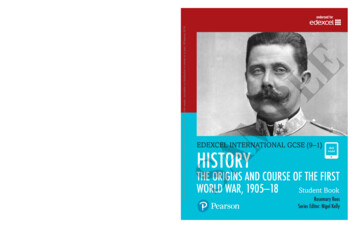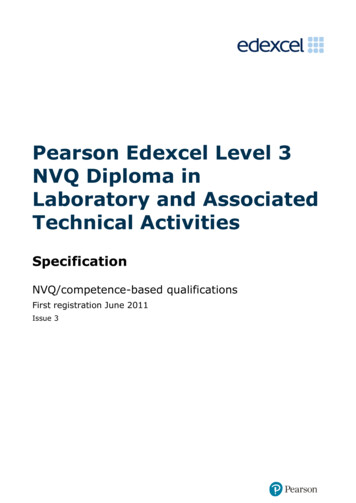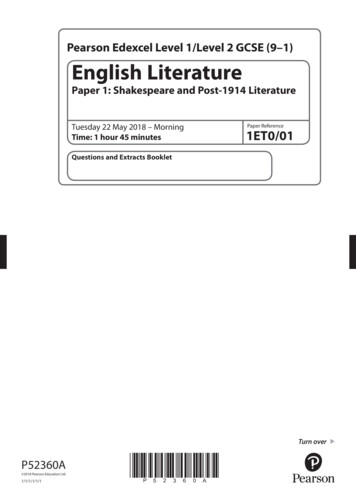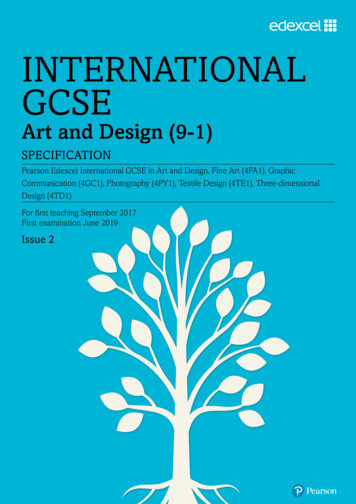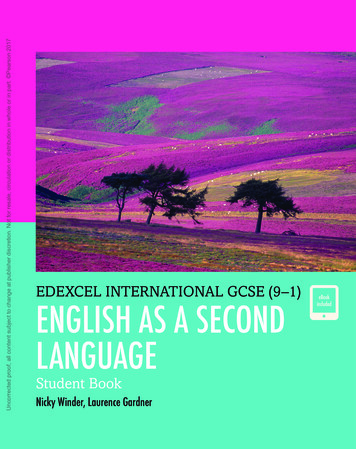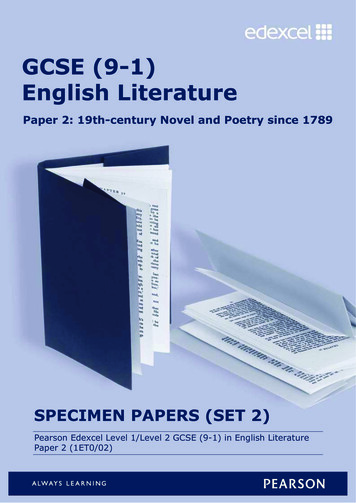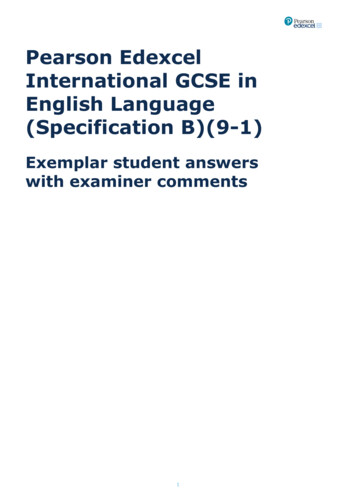
Transcription
Pearson EdexcelInternational GCSE inEnglish Language(Specification B)(9-1)Exemplar student answerswith examiner comments1
ContentsAbout this booklet . 3How to use this booklet . 3Section A. 4Exemplar Question 1 . 4Exemplar Question 2 . 7Exemplar Question 3 . 10Exemplar Question 4 . 20Exemplar Question 5 . 23Exemplar Question 6 . 26Exemplar Question 7 . 36Section B . 45Exemplar Question 8 . 45Section C . 59Exemplar Question 9 . 592
About this bookletThis booklet has been produced to support mathematics teachers delivering the newInternational GCSE in English Language (Specification B).The booklet looks at questions from the Sample Assessment Materials, and somerelevant questions from past papers. It shows real student responses to these questions,and how the examining team follow the mark scheme to demonstrate how the studentswould be awarded marks on these questions.How to use this bookletOur examining team have selected student responses to all 11 questions. Following eachquestion you will find the mark scheme for that question and then a range of studentresponses with accompanying examiner comments on how the mark scheme has beenapplied and the marks awarded, and on common errors for this sort of question.StudentresponseMarks awardedfor the questionor questionpartsExaminer commentaryon the studentresponse3
Exemplar Question 1Section AExemplar Question 1Read Text One in the Extracts Booklet, from First Impressions - anEnglishman in New York, which is about a man’s first experience of NewYork.1. In lines 17-22 the writer describes the immigration process.Identify one point the writer makes about the experience.(Total for Question 1 1 mark)Mark SchemeQuestionAnswerMarksnumber1One mark for any one of the following: going to take a long time nothing to do the video on a continuous loop passport check was quick and painless unusual to be photographed and finger-printed.(1)4
Exemplar Question 1Student Response A1/1Examiner CommentsAn accurate answer is given.Student Response B1/1Examiner CommentsAn accurate answer is given.5
Exemplar Question 1Student Response C1/1Examiner CommentsAn accurate answer is given.Student Response D1/1Examiner CommentsAn accurate answer is given.6
Exemplar Question 2Exemplar Question 22. In lines 23-34, the writer leaves the airport and travels into the city.State one thing the writer sees.Total for Question 2 1 mark)Mark SchemeQuestionAnswerMarksnumber2One mark for any one of the following: Starbucks/McDonald’s warning signs about dodgy taxis yellow taxis same type of cars as in Europe some vehicles are different/Jeeps/stretchlimousines/vans the skyline/Queensboro Bridge.(1)7
Exemplar Question 2Student Response A1/1Examiner CommentsAn appropriate sighting is given.Student Response B1/1Examiner CommentsAn appropriate sighting is given.8
Exemplar Question 2Student Response C1/1Examiner CommentsAn appropriate sighting is given.Student Response D1/1Examiner CommentsAn appropriate sighting is given.9
Exemplar Question 3Exemplar Question 33. Explain how the writer presents his impressions of New York.You should support your answer with close reference to the passage, includingbrief quotations.(Total for Question 3 10 marks)Mark SchemeQuestionAnswerMarksnumber3Reward responses that demonstrate how the writer presentshis impressions of New York.Responses may include: the use of descriptive language to create a sense ofunfamiliarity – ‘not quite what I was used to, being29 floors up’ repetition to create a sense of wonder – ‘The Midtownlocation was amazing’, ‘It’s also (to my ears)amazing’ the use of typical New York features – ‘those yellowfire hydrants’, ‘newspaper vending machines’,‘‘Walk/Don’t Walk’ signs’ excitement caused by familiar locations – ‘The feelingof being on a film set’ the use of a simile to describe the level of the noise –‘it’s like somebody turned the volume up’ he is surprised by the uninhibited privateconversations of the pedestrians – ‘fascinating insightinto the private lives of New Yorkers’ the way he makes the buildings sound impressive –‘how mind-blowing New York architecture really is’ he encourages the reader to share his experiences –‘New York lived up to and in fact exceeded myexpectations – it should be on everyone’s list ofplaces to visit’ the use of colloquial and informal language engagesthe reader – ‘wow’, ‘The Big Apple’ he creates a strong sense of location through the useof proper nouns – ‘Manhattan’, ‘Empire StateBuilding’, ‘Queensboro Bridge’, ‘Rockefeller Center’ the use of the first person creates a sense ofrealism/immediacy – many examples.10(10)
Exemplar Question 3Student Response A11
Exemplar Question 36/10Examiner CommentsThis is a Level 3 response to the question on the writer’s impression of New York, as itdemonstrates clear understanding and has appropriate examples. The comments are not sufficientlydeveloped to move it into Level 4, for which a closer analysis of language and structure would berequired.12
Exemplar Question 3Student Response B13
Exemplar Question 314
Exemplar Question 36/10Examiner CommentsThis is a response which shows a clear understanding of the way in which the writer shows hisimpressions of New York and makes appropriate references. The comments on how the writerrefers to the architecture are made well, with analysis of metaphor.15
Exemplar Question 3Student Response C16
Exemplar Question 38/10Examiner CommentsThorough understanding is shown, with references which support the points that are made. Theresponse engages with the writing, looking at specific techniques in a thoughtful way. A little moreperceptive development of the points would have taken this response into Level 5.17
Exemplar Question 3Student Response D18
Exemplar Question 34/10Examiner CommentsThere is some sound understanding and valid reference to the text is made. The candidate’s pointsare not always supported in a fully secure way, but there is relevance.19
Exemplar Question 4Exemplar Question 4Read Text Two in the Extracts Booklet, from Notes from a Small Island,which is about a journey the writer makes to Dover in England.4. In lines 1-22, the writer describes his journey to the ferry terminal.State one of the difficulties the writer experienced.(Total for Question 4 1 mark)Mark SchemeQuestionAnswerMarksnumber4One mark for any one of the following: inadequate (little) map was 2 miles away wasteland/factories/industrial units are in his way chainlink fence it’s getting late he’s not getting any nearer dual carriageway embankment.(1)20
Exemplar Question 4Student Response A1/1Examiner CommentsA correct example of a difficulty is given.Student Response B0/1Examiner CommentsThe point about the writer’s arriving ‘breathless and late’ is not a valid one, as it does not refer todifficulties faced by the writer.21
Exemplar Question 4Student Response C1/1Examiner CommentsA correct example of a difficulty is given.Student Response D1/1Examiner CommentsA correct example of a difficulty is given.22
Exemplar Question 5Exemplar Question 55. In lines 23-32, the writer describes the ferry crossing.Name two things the writer finds unpleasant.(Total for Question 5 2 marks)Mark SchemeQuestionAnswerMarksnumber5One mark each for any two of the following: seasick crowded boat busy duty-free shop limited seating badly-behaved children bad weather.(2)23
Exemplar Question 5Student Response A2/2Examiner CommentsTwo unpleasant experiences are recorded.Student Response B2/2Examiner CommentsTwo unpleasant experiences are recorded.24
Exemplar Question 5Student Response C0/2Examiner CommentsNo response.Student Response D1/2Examiner CommentsOne point is clearly made and fully relevant. The second, however, does not quite score the point,as the example given does not quite indicate the writer’s sense of things being unpleasant.25
Exemplar Question 6Exemplar Question 66. How does the writer describe his thoughts and feelings about his trip to Dover?You should support your answer with close reference to the passage, includingbrief quotations.(Total for Question 6 10 marks)Mark SchemeQuestionIndicative contentMarksnumber6Reward responses that demonstrate how the writer describeshis thoughts and feelings about his trip to Dover.Responses may include: the writer’s use of optimism – ‘another promisingday’ the use of sentence structure to convey his increasingconcern over missing his ferry the use of onomatopoeia to highlight his anxiety –‘whimpering panic’ he is nervous about the ferry crossing – ‘a certaindisquiet’ descriptive language to emphasise the chaos insidethe ferry – ‘mayhem’, ‘dementedly lively’, ‘quicklyfound my way out again’ the anticipation of seeing Dover again after manyyears – ‘eager to see Dover again’ the use of contrasts: he was pleased that somethings had not changed – ‘small cry of pleasure’, ‘Theview out to sea was likewise unchanged’; he wasmiserable – ‘plodded distractedly’, ‘unhappy’,‘grumbling’ the use of personification to show how shocked he isby the changes in Dover – ‘more menacing’,‘uncomfortably squeezed’ he feels as if he could be anywhere in England – ‘soindistinguishable’ he is relieved to finally get his bearings – ‘everythingsuddenly became clear’, ‘strode purposefully’ the extract ends on a happier note – ‘Cheered by thisthought’ the use of the first person creates a sense ofrealism/immediacy – many examples.(10)26
Exemplar Question 6LevelLevel 1MarkAO2 Understand and analyse how writers use linguistic andstructural devices to achieve their effects0No rewardable material.1–2 Basic identification and little understanding of thelanguage and/or structure used by writers to achieveeffects. The use of references is limited.Level 23–4 Some understanding of and comment on language andstructure and how these are used by writers to achieveeffects, including use of vocabulary. The selection of references is valid, but not developed.Level 35–6 Clear understanding and explanation of language andstructure and how these are used by writers to achieveeffects, including use of vocabulary and sentencestructure. The selection of references is appropriate and relevant tothe points being made.Level 47–8 Thorough understanding and exploration of language andstructure and how these are used to achieve effects,including use of vocabulary, sentence structure and otherlanguage features. The selection of references is detailed, appropriate andfully supports the points being made.Level 59–10 Perceptive understanding and analysis of language andstructure and how these are used by writers to achieveeffects, including use of vocabulary, sentence structureand other language features. The selection of references is discriminating and clarifiesthe points being made.27
Exemplar Question 6Student Response A28
Exemplar Question 67/10Examiner CommentsSome thorough understanding and detailed references indicate that this merits a mark in Level 4,although the analysis would have needed to be sharper to make it worthy of the next Level. Thecomments pick out some good examples of effective language.29
Exemplar Question 6Student Response B30
Exemplar Question 65/10Examiner CommentsSome clear understanding and comment but it is not always sufficiently developed. It just meets theLevel 3 descriptors on the ‘best fit’ principle, with some valid points about how Bryson sustains thereader’s interest.31
Exemplar Question 6Student Response C32
Exemplar Question 64/10Examiner CommentsSome understanding, so worth a Level 2 mark. However, the candidate loses focus on thoughts andfeelings, and approaches the question as being purely about writing techniques.33
Exemplar Question 6Student Response D34
Exemplar Question 64/10Examiner CommentsThis is a response meriting a mark in Level 2, as some relevant comment on language is offeredand there are valid references. To have moved the mark beyond Level 2, it would have beennecessary to give a fuller analysis of the way in which effects are achieved to describe thoughts andfeelings: there is perhaps over-reliance on sentence length, whether short or long.35
Exemplar Question 7Exemplar Question 7Refer to BOTH Text One AND Text Two to answer the following question.7. Compare how the writers of Text One and Text Two convey their ideas andexperiences.Support your answer with examples from both texts.(Total for Question 7 15 marks)Mark SchemeQuestionIndicative contentMarksnumber7Responses may include the following points:Text One the writer conveys the experience as a positive one,for example: ‘really looking forward’, ‘spirits high’,‘spectacular’, ‘wow’, ‘iconic’, amazing’ he is apprehensive about the immigration processwhich starts negatively – ‘sweaty tunnels’, ‘a longtime’ – but ends positively – ‘quick and painless’ his attention to the detailed description of manyfamiliar features to help the reader feel included –‘yellow taxis’, ‘fire hydrants’, ‘skyscrapers’,‘Walk/Don’t walk signs’, ‘Empire State Building’,‘Rockefeller Centre’ he conveys how he is overwhelmed by ‘the sheerlevel of noise on the streets’ he conveys how enjoyable it was by using hyperbole– ‘mind-blowing’, ‘exceeded my expectations’.General points candidates may make on the whole ofText One the text is broken up by sub-headings making iteasier to read the use of positive language throughout conveys thewriter’s enjoyable experience the use of a slightly colloquial/chatty style – ‘kickingin’, ‘check out’, ‘the real ‘wow’ factor’, ‘mind-blowing’– makes the reader feel engaged36
Exemplar Question 7QuestionIndicative contentMarksnumber7Text Two the writer of Text Two is equally positive at the start,with the use of ‘promising’ he conveys an experience that quickly deteriorates –‘inadequate little map’ with a catalogue of negativelanguage to describe the way to the terminal –‘bewildering wasteland’ (metaphor), ‘derelictfactories’, acres of waste ground’ (hyperbole), ‘jaggedconcrete’, ‘rusting railway carriages’ (alliteration),‘broken windows’ the way he lists his ideas, feelings and behaviour –‘whimpering panic’, ‘dodging’, ‘clambering’,‘breathless’, ‘like someone who’d just survived amining disaster’ (simile) his experience of the ferry crossing is unnerving andexaggerated – ‘certain disquiet’, ‘crammed’, ‘hordesof dementedly lively children’, ‘people with blue lipsand dancing hair’ (metaphor) his reactions on arriving contrast with his experienceon the ferry – ‘eager’, ‘strode’, ‘small cry of pleasure’ how he describes his disappointment at the changesto Dover – ‘vast and unbecoming’, ‘more menacing’,‘unrecognisable’, ‘uncomfortably squeezed’ how he describes his mixed feelings at the end –‘distractedly’, ‘unhappy’, ‘grumbling’, ‘strodepurposefully’, ‘Cheered by this thought’General points candidates may make on the whole ofText Two the use of negative language throughout conveys theunpleasant experience the writer had there is the use of humour which shows that thewriter may see the funny side of the experiencePoints of comparison Text One is positive/Text Two is negative Text One is more informative/Text Two is about hispersonal experience Text Two uses humour both texts are informal both texts are about arriving in a city/town both texts describe what the writers saw both texts convey clearly the writers’ ideas andexperiences.Reward all valid points.(15)37
Exemplar Question 7LevelLevel 1Level 2MarkAO3 Explore links and connections between writers’ ideasand perspectives, as well as how these are conveyed0No rewardable material.1–34–6 The response does not compare the texts. Description of writers’ ideas and perspectives,including theme, language and/or structure. The use of references is limited. The response considers obvious comparisons betweenthe texts. Comment on writers’ ideas and perspectives,including theme, language and/or structure. The selection of references is valid, but notdeveloped.NB: candidates who have considered only ONE textmay still achieve a mark up to the top of Level 2Level 3Level 4Level 57–910–1213–15 The response considers a range of comparisonsbetween the texts. Explanation of writers’ ideas and perspectives,including theme, language and/or structure. The selection of references is appropriate andrelevant to the points being made. The response considers a wide range of comparisonsbetween the texts. Exploration of writers’ ideas and perspectives,including theme, language and/or structure are usedacross the texts. References are balanced across both texts and fullysupport the points being made. The response considers a varied and comprehensiverange of comparisons between the texts. Analysis of writers’ ideas and perspectives, includingtheme, language and/or structure are used across thetexts. References are balanced across both texts; they arediscriminating and fully support the points beingmade.38
Exemplar Question 7Student Response A4/15Examiner CommentsThere is an attempt at content-based comparison and relevant references are made. This thereforedeserves a mark in Level 2, even if it is not a complete response. To improve the quality of thisresponse, for which 15 marks are available, a fuller exploration of the different ways in which thetwo writers convey their experiences, set out in a comparative way, would have been required.39
Exemplar Question 7Student Response B40
Exemplar Question 75/15Examiner CommentsThere is a clear attempt at comparison but it is undeveloped. The suggestion that the two passageshave different purposes is a worthwhile one, and there is an attempt to show differences in tone anddescriptive techniques, though this would have needed to be more fully amplified for a higher Levelmark.41
Exemplar Question 7Student Response C42
Exemplar Question 77/15Examiner CommentsThe opening sentence directly compares the two texts. This is followed by a range of points withexamples, although sometimes the comparison is implicit.43
Exemplar Question 7Student Response D1/10Examiner CommentsThere is very little here: the answer is clearly not finished, perhaps because time ran out. Thecandidate needed to remember that this is the question with the highest marks in Section A, andhence to leave enough time for a full and sustained response.44
Exemplar Question 8Section BExemplar Question 88. A friend of yours is going abroad for the first time.Write a letter to your friend explaining what it might be like.You should include: what might be seen or experienced what might be enjoyable what might be disappointing.Think carefully about the purpose of your letter and the audience for whom it isintended.(Total for Question 8 30 marks)45
Exemplar Question 8Mark SchemeQuestionIndicative contentMarksnumber8A suitable register for a letter to a friend should be adopted.Candidates should address all areas. The following are somepoints that candidates may make but there are otherpossibilities.What might be seen or experienced: skyscrapers (in clouds) long queues the vehicles the beautiful views the strange environment (29 floors up) seeing things familiar from films/TV the noise crowds noisy children ugly modernisationWhat might be enjoyable: the sights the views from where you stay seeing lots of things you recognise from films/TV overhearing strangers’ conversations the amazing buildings seeing familiar placesWhat might be disappointing: waiting at passport control most cars are the same as at home how noisy it is problems getting to the terminal how crowded the ferry is how unpleasant many buildings are many towns are very similarReward all valid points.(30)46
Exemplar Question 8LevelMarkLevel 00Level 11–2AO1 Read and understand a variety of texts, selecting andinterpreting information, ideas and perspectivesNo rewardable material. Selection and interpretation of the given bullet points islimited. Includes a small number of points with some relevance. Demonstrates a limited ability to locate and retrieveinformation and ideas.Level 23–4 Selection and interpretation of the given bullet points isvalid, but not developed. Gives some relevant points. Brings in some relevant information and ideas.Level 35–6 Selection and interpretation of the given bullet points isappropriate and relevant to the points being made. Offers a reasonable number of relevant points. Shows secure appreciation of information and ideas.Level 47–8 Selection and interpretation of the given bullet points isappropriate, detailed and fully supports the points beingmade. Offers a good number of relevant points. Makes well-focused comments about information andideas.Level 59–10 Selection and interpretation of the given bullet points isapt and is persuasive in clarifying the points being made. Offers a wide range of relevant points. Presents well-focused comments with perceptivereferences to information and ideas.47
Exemplar Question 8LevelLevel 1MarkAO4 Communicate effectively and imaginatively, adaptingform, tone and register of writing for specific purposesand audiences0No rewardable material.1–2 Communication is at a basic level, and limited in clarity. Little awareness is shown of the purpose of the writingand the intended reader. Little awareness of form, tone and register.Level 23–4 Communicates in a broadly appropriate way. Shows some grasp of the purpose and of theexpectations/requirements of the intended reader. Straightforward use of form, tone and register.Level 35–7 Communicates clearly. Generally shows clear sense of purpose andunderstanding of the expectations/requirements of theintended reader. Appropriate use of form, tone and register.Level 48–10 Communicates successfully. Shows a secure realisation of the writing task accordingto the writer's purpose and theexpectations/requirements of the intended reader. Effective use of form, tone and register.Level 511–12 Communication is perceptive and subtle withdiscriminating use of a full vocabulary. Task is sharply focused on purpose and theexpectations/requirements of the intended reader. Sophisticated control of text structure, skilfullysustained paragraphing as appropriate and/or assuredapplication of a range of cohesive devices.48
Exemplar Question 8LevelLevel 1MarkAO5 Write clearly, using a range of vocabulary and sentencestructures, with accurate spelling, paragraphing, grammarand punctuation0No rewardable material.1–2 Some basic punctuation is used. Grammatical structuring shows some control. Spelling of common words is usually correct, thoughinconsistencies are present.Level 23–4 Control of punctuation is mostly secure. Grammatical structures are mostly accurate and used toconvey meanings. Spelling of a range of words is mostly accurate.Level 35–6 Punctuation is accurate, with a range of marks used toenhance communication. A range of grammatical structuring is used accurately andeffectively. Spelling is almost always accurate, with occasional slips.Level 47–8 Control of the full range of punctuation marks is precise, forexample by the deployment of semi-colons, pairs ofcommas or dashes to indicate apposition or interpolation. Grammatical structuring is ambitious and assured, withsophisticated control of expression and meaning. Spelling of a wide and ambitious vocabulary is consistentlyaccurate.49
Exemplar Question 8Student Response A50
Exemplar Question 828/30Examiner CommentsAO1 – The candidate successfully draws on ideas from the two texts, while avoiding beingdependent on them for content or context. The choice of Ireland as a destination is successful, witha convincing sense of place. The Interpretation of the bullets is apt and persuasive, with a widerange of relevant points.AO4 – The writing is sharply focused and sophisticated - a lively response.AO5 – Technically, the writer shows sophisticated control and ambitious vocabulary, whichcommunicates very effectively, despite a few technical slips.51
Exemplar Question 8Student Response B52
Exemplar Question 824/30Examiner CommentsAO1 – Ideas are for the most part drawn from Text 1, but there is coverage of a reasonable numberof relevant points.AO4 – The candidate writes a successful and effective letter, with a secure sense of audience andpurpose, established quickly through the direct and engaging opening.AO5 - The writing is accurate and sometimes ambitious.53
Exemplar Question 8Student Response C54
Exemplar Question 855
Exemplar Question 820/30Examiner CommentsAO1 – The response touches on the third bullet point about potential disappointments, but there area reasonable number of relevant points, drawing on the source materials in an appropriate way.AO4 – The candidate has written a letter that communicates successfully, with a sound awarenessof audience and purpose.AO5 – The writing is mostly accurate, but with occasional slips of both spelling (eg ‘skyscrappers’)and punctuation (eg ‘its’, with the apostrophe omitted)56
Exemplar Question 8Student Response D57
Exemplar Question 88/30Examiner CommentsAO1 – The candidate makes some relevant points but expression impedes clarity, as the meaning isnot always conveyed in a way which is easily understood.AO4 – The communication is broadly appropriate, but again weaknesses of expression impedeclear understanding. There is some grasp of purpose and an awareness of audience is shown.AO5 - Although there is much accurate spelling there are problems with grammatical control andexpression.58
Exemplar Question 9Section CExemplar Question 9Write approximately 400 words on one of the following:EITHER9. ‘To travel is better than to arrive.’ Discuss.(Total for Question 9 30 marks)OR10. Write a story (true or imaginary) entitled ‘The Beginning’.(Total for Question 10 30 marks)OR11. Describe a place that has made an impression on you.(Total for Question 11 30 marks)59
Exemplar Question 9Mark SchemeQuestionnumberIndicative contentMarks9As no audience is specified, the examiner is assumed to be theaudience.Candidates are free to agree or disagree with the statementand may present a variety of arguments.Content may include references to: it depends where you aregoing; how you are getting there; who you are travelling with;why you are travelling; what mode of transport is being used.Examiners should be open to a wide range of interpretation.(30)QuestionnumberIndicative contentMarks10No indicative content can be specified, since candidates maychoose to interpret the title as they wish.Candidates should be rewarded for such qualities as a sense ofdrama, vivid description, excitement or suspense.NB: Explicit reference to the title may not be mentioned untilthe end of the story.Examiners should be open to a wide range of interpretation.(30)QuestionnumberIndicative contentMarks11Candidates may have quite a wide choice of places – real orimaginary. They may refer to whole neighbourhoods, towns,villages or a street. It may be a small or large area, indoors oroutdoors. They may describe a building or a room. The placemay have personal or spiritual significance.Candidates should be rewarded for their powers to evoke asense of place and atmosphere, using effective vocabulary.Examiners should be open to a wide range of interpretation.60(30)
Exemplar Question 9LevelLevel 1MarkAO4 Communicate effectively and imaginatively, adapting form,tone and register of writing for specific purposes andaudiences0No rewardable material.1–4 Communication is at a basic level, and limited in clarity. Little awareness is shown of the purpose of the writingand the intended reader. Little awareness of form, tone and register.Level 25–8 Communicates in a broadly appropriate way. Shows some grasp of the purpose and of theexpectations/requirements of the intended reader. Straightforward use of form, tone and register.Level 39–12 Communicates clearly. Generally shows clear sense of purpose andunderstanding of the expectations/requirements of theintended reader. Appropriate use of form, tone and register.Level 413–16 Communicates successfully. A secure realisation of the writing task according to thewriter's purpose and the expectations/requirements ofthe intended reader
Exemplar Question 1 4 Section A Exemplar Question 1 Read Text One in the Extracts Booklet, from First Impressions - an Englishman in New York, which is about a man’s first experience of New York. 1.In

